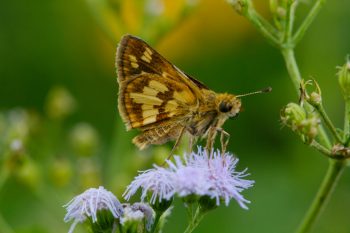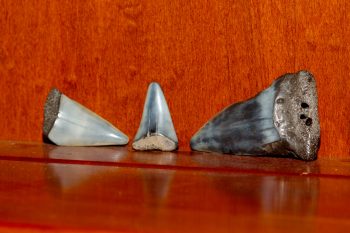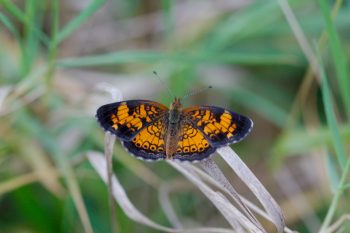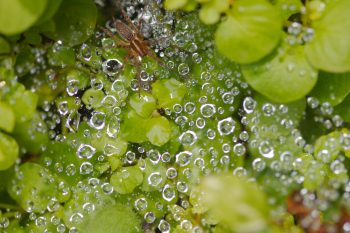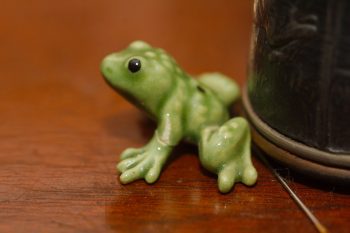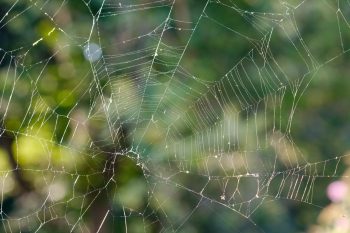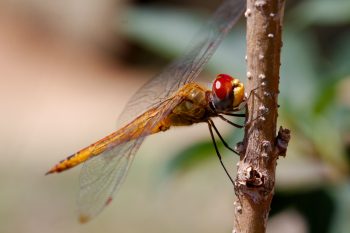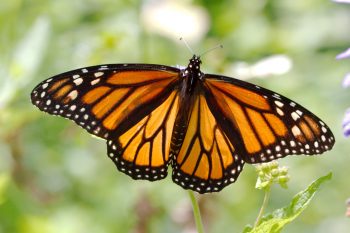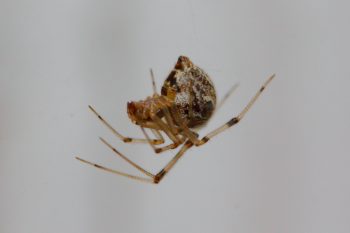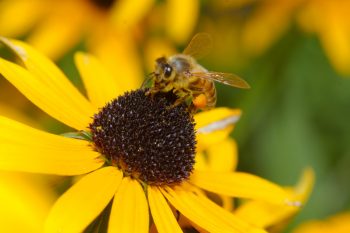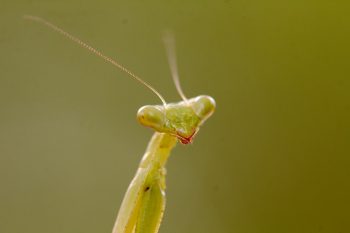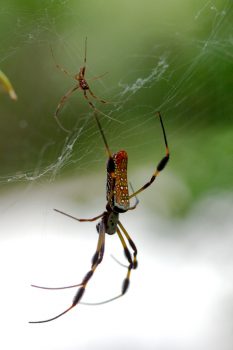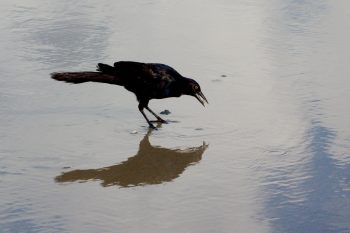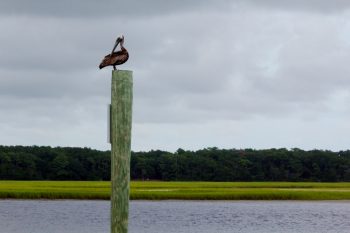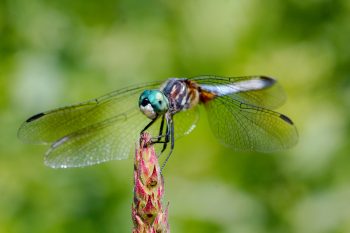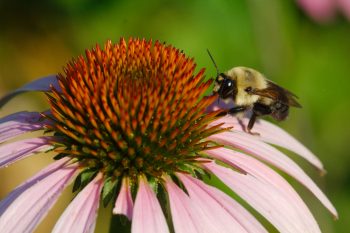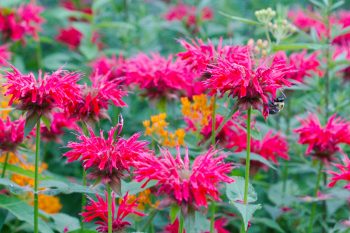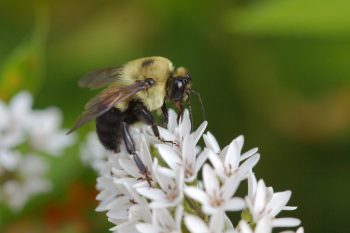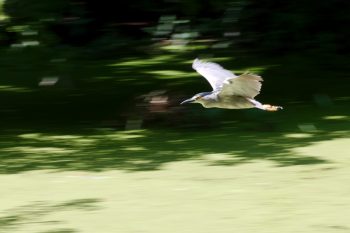As you walk through a lawn, chances are there are insects jumping away from you much of the time. We often walk through life not noticing things like that. Many of the insects are too small to be of any note. Slightly larger insects, like this cricket, might catch our eye but still not attract much attention. I went out today specifically looking at the little creatures all around and was able to get fairly close to this one before it hopped away. I haven’t had a chance to look it up to get any sort of identification beyond “cricket” but that’s probably good enough for now.
Creatures
Peck’s Skipper (Polites peckius)
It was dark and raining this morning and into the early afternoon but by 5:00 PM or so the sun was out and it was a beautiful day. I wouldn’t actually have minded the clouds staying around because our air conditioner has called it quits and a little less direct sun would have been welcome. Still, it was nice to get out and look for insects to photograph. This little fellow, a Peck’s skipper (Polites peckius), was on some blue mistflower (Conoclinium coelestinum) in the front garden. I also got some pictures of an eastern tailed-blue (Cupido comyntas) but they weren’t very sharp. Quite shy, those little blues.
Sharks’ Teeth
Apparently my great Uncle Charles was good at finding sharks’ teeth. We found a box of them in my mom’s basement and she said he had found them and given them to her either at one time or at various times over the years. She said they mostly came from southern Maryland or from North Carolina but we don’t really know that with any certainty. They vary quite a bit in size and there are some considerably larger than the one on the right here. Those are not complete and they are quite worn, though. The one in the middle is one of the best in terms of having a sharp edge. In the box was also a stone arrowhead, which I assume was also found by him.
Pearl Crescent (Phyciodes tharos)
I stopped at the commuter parking lot on Georgia Avenue where it crosses the Intercounty Connector today and took some pictures of insects on wildflowers growing on the hillside above the parking lot. I had originally stopped because there were beautiful clouds to the northwest but by the time I got there the sky was pretty much a uniform grey. There were goldenrod soldier beetles (Chauliognathus pensylvanicus) all over the goldenrod (which makes a lot of sense) and there were quite a few types of bees. I followed this little butterfly around a while until I was able to get close enough for a few decent photographs. The one taken after this is considerably closer but not as sharp, unfortunately. The dwindling light from the heavy overcast was makign it hard. But I enjoyed being out in the wind and with insects all around.
Funnel Weaver
It’s funnel weaver time in the yard. They build webs in the grass and in the garden where the plants aren’t too tall. When it’s humid and the dew settles on the grass, they are particularly easy to find because of the beads of water on the webs. I believe that this is a grass spider (genus Agelenopsis). They generally disappear into the funnel at the side of there web when I get too close but with a bit of patience they can be seen. While I’m not a fan of having spiders crawling on me or having spider webs in my face, I like them for what they eat, so I left them be, for the most part.
Green Ceramic Frog
This little green, caramic frog is sitting on our piano. I’m not sure exactly where it came from. Cathy probably knows but I haven’t bothered to ask. It probably showed up in a box at her mom’s house sometime in the last nine months. I don’t remember when it appeared on the piano, but there it is. As you may be able to see, it’s front left leg has been broken. It doesn’t affect the frogs ability to hop, though. That’s mostly because ceramic frogs don’t move very much, I suppose.
Spider Web
The afternoon sun was lighting up three or four prominent spider webs today. Spider webs can be tricky to photograph. In particular, you can pretty much forget about auto-focus, unless there is something substantial caught in the web (or if the spider is there, which is sometimes enough). Another thing is that you want them to show up against whatever background is available. If the web is lit by the sun, as this one is, then you want a relatively dark background. This is an old web, not obviously inhabited any more. One of the others I photographed had a spider on it, although she scurried for cover when I got close. I did get one picture of an orchard spider (Leucauge venusta) on her web, though.
Wandering Glider (Pantala flavescens)
In a rare turn for late August, it was very pleasant outside today. The high probably wasn’t over about 82°F and it wasn’t humid at all. In the shade it was quite comfortable. To capitalize on such a nice day, Cathy and I met and took a walk around our company campus. Almost immediately when I went outside, I spotted this dragonfly, which I believe to be a wandering glider (Pantala flavescens), one of the skimmers. That ID may be wrong, but nevertheless, it’s a beautiful thing, with its dark yellow markings and striking red eyes.
Monarch (Danaus plexippus)
I got a few nice arthropod photos today, one spider (a Basilica Orbweaver (Mecynogea lemniscata) and a few bees. My post for today came down to a choice between this monarch and a photo of a Philanthus gibbosus, one of the thirty-some species of beewolves in our area. It’s a pretty little bee with pitted chitin and a distinctive pattern of yellow and black. I photographed it on a black-eyed Susan, which went well with its coloration. Nevertheless, I’ve decided to go with this rather nice photo of a monarch butterfly (Danaus plexippus). Oddly, most people who dislike insects don’t really mind butterflies. It’s true that they are pretty harmless to humans but then, so are a lot of other, more easily despised insects. Maybe it’s because they are so colorful and pretty, but frankly, I think wasps are pretty, so there.
Cobweb Spider
It’s spider time in Maryland. There are spiders around all year long, of course. It’s said that you are never more than six feet from a spider*. Nevertheless, they are much more noticeable in the heat of late summer. We have quite a few living in the garden and yard and I have no problem with that. They eat things I like less than spiders. This one is just outside our living room window on a fairly impressive web. Getting into a good position to photograph it was a bit tricky, as I didn’t want to disturb it or ruin its web. I know I have a few followers who aren’t crazy about my spider photos (or other creepy-crawly things) but I think they are beautiful, in their own way. This is, I believe, a cobweb spider in the genus Parasteatoda.
* There are probably exceptions to this, for instance if you are floating in the ocean (without a boat), you may be more than six feet from a spider.
Honey Bee on Rudbekia
As I’ve mentioned before, the garden is somewhat overrun with Rudbekia (a.k.a. black-eyed Susan) flowers. The bees don’t mind. There are, actually, other things in bloom, but none nearly as obvious. The mountain mint (Pycnanthemum muticum), for instance, is very popular with the bees of all sorts. But their flowers are much less showy. This afternoon I took a bunch of pictures of various bees on the black-eye Susan flowers. This one is a western honey bee, Apis mellifera. Contrary to popular belief, they are in no real danger of all dying out. You can, to a large degree, thank capitalism for that, although I think the danger was considerably exagerated, in any case.
Praying Mantis
After work I met my mom at her house and we emptied the garage. I have a few pictures of it, showing how it’s leaning, particularly at the back. We loaded trash into her van to take to the county transfer station and I took a few things to give away or otherwise deal with. When I got home and was unloading my van I noticed this praying mantis on the roof of Margaret’s car. I believe but am not sure that it is a Chinese mantis (Tenodera sinensis). I think it is not fully grown, as it was only about two inches long. Like true bugs, grasshoppers, cockroaches, and crickets (to name a few), the mantises undergo what is known as incomplete metamorphosis. That is, instead of larval and pupal stages, the emerge from their eggs as nymphs and grow through a series of instars, where they shed their exoskeletons as they grow.
Nephila clavipes (Golden Silk Orbweaver)
I know that for many people, the phrase, “one of my favorite spiders” is not even a thing. Nevertheless, this is one of my favorite spiders. The Golden Silk Orbweaver (Nephila clavipes) is quite large. Nothing like a tarantula and only hairy at the leg joints, but still pretty good sized. The body of females grow up to almost 2 inches. This on is about an inch and a half. The male, seen at the top of the picture, is considerably smaller. North Carolina is about as far north as this spider is found but it is fairly common in the marshy woods here. Because of their size, they are fairly easy to spot. That’s just as well because you probably won’t be happy when you walk into the web as you go through the woods.
The silk from this spider is a golden color. Scientists have analyzed the dragline silk of this spider’s web and attempted to reproduce its proteins artificially for use in high-strength fabrics.
Grackle Eating a Clam
We went swimming early this afternoon and then I dug in the sand and made a drip castle. After showering, Cathy and I walked on the beach. I was surprised that the castle was still there. The tide hadn’t come in yet but no one had stepped on it. On our walk we saw a few common grackles (Quiscalus quiscula) just above the surf pulling up clams after each wave. It’s not really surprising that they’ve learned to enjoy clams. It’s just that we don’t think of grackles as shore birds, skipping around at the top of the surf along with willets and sand pipers.
Brown Pelican (Pelecanus occidentalis)
We had a bit of rain this morning but it cleared up later and we went swimming. Late in the day I went for a little drive to find somewhere to take pictures. On the mainland near the east end of the island is a boat ramp. There used to be a ferry across to the island there and it’s a pretty place. I took some pictures of marsh grass growing on the banks of the channel and also got a nice photo of a tiger swallowtail (Papilio glaucus). From there I drove to the Shallotte River inlet and took some pictures of this brown pelican (Pelecanus occidentalis) perched on a pole out in the water.
Dragonfly
Dorothy thought she had to work from 4:00 to 9:00 PM today but she got a text just after 11:00 saying she was on from 11:00 to 4:00. Fortunately, we were just driving through campus as she got that, so we were there within minutes. Cathy and I enjoyed a walk around Coy Pond and I took a bunch of pictures, including of water lilies, a great blue heron, and this dragonfly. Later we went to the garden at Long Hall and I took more pictures. That was a nice garden with an interesting collection of trees, shrubs, and perennials. Recommended. We had dinner at La Victoria, a trendy but decent taco place just off of Cabot Street in Beverly.
Bumble Bee on Coneflower
The coneflowers (Echinacea purpurea) in our yard tend to get eaten up by insects of one sort or another. I’m not sure who the culprit actually is, but they eat holes in the ray florets (the petals around the central group of disc florets), making the flowers a bit less attractive for photography. The bees aren’t bothered, of course, and this bumble bee (Bombus impatiens). The generic name Echinacea comes from the Greek word meaning hedgehog or sea-urchin, which references the spiny center of the flower. The name Bombus for bumble bees comes from the Latin (which took it from the Greek) for “booming, buzzing, humming.”
Monarda, Asclepias, and a Bombus
Along our back fence, the garden has really gotten out of control. With the work we’ve been doing on our mom’s houses, we haven’t really had time to give it half the attention it needs and deserves. Consequently, it’s got goldenrod, poke weed, and thistles growing in abundance. Three of our planted perennials are doing quite well, however, including the bee balm (Monarda didyma, also known as Oswego tea or bergamot) and the butterfly weed (Asclepias tuberosa) shown here. The other, not yet in bloom, is obedient plant (Physostegia virginiana). All three are native to the area and extremely tough. The bees love them and I followed this common eastern bumble bee (Bombus impatiens) for a while as he moved from flower to flower.
Eastern Bumblebee (Bombus impatiens)
The gooseneck loosestrife (Lysimachia clethroides) is in bloom and that generally means I have an opportunity to photograph common eastern bumblebees (Bombus impatiens) like this one. I don’t recommend planting loosestrife unless you really enjoy digging up plants where they appear throughout your garden. It can easily get ahead of you. We sometimes joke about planting two aggressive plants in a container and waiting to see which comes out on top. This has got to be a contender. It does have nice flowers, though, and its attractiveness to bees speaks well of it. Nevertheless, if I could get rid of all we had, I wouldn’t think twice about it.
Riley’s Lock
Cathy and I went for a walk along the C&O Canal today after church. We each brought a change of clothes because it was much too hot for even casual church clothes today. We walked west (upstream) on the tow path and enjoyed the fact that it’s pretty shady. With a temperature above 95°F in the shade, we certainly didn’t need to be out in the sun. We’re neither mad dogs nor Englishmen.
As you would expect, I brought my camera with me and we saw a little wildlife. First was this dragonfly. The female and the immature male of the eastern pondhawk (Erythemis simplicicollis) are an emerald green. The adult male, however, transitions to a dark, powder blue, as seen here.
I got some nice photos of buttonbush (Cephalanthus occidentalis), a flowering shrub native to the area. It’s a member of the coffee family, Rubiaceae and it has very interesting, spherical florets.
At the turning basin just above the aqueduct we saw a great blue heron (Ardea herodias) although the way it was lit and because it was pretty far away, I wasn’t sure that’s what it was. Of course, there aren’t a lot of birds that size around here. A little further on we saw a black-crowned night-heron (Nycticorax nycticorax). I had stopped to take a picture of a family of ducks in the canal, which was full of duck weed. That meant I was ready when the heron flew past and I was able to get this shot.


